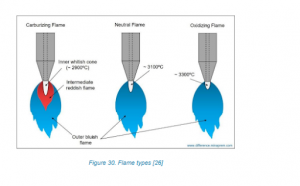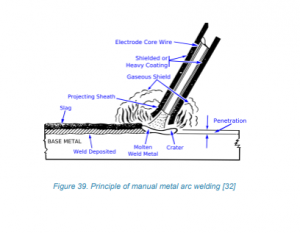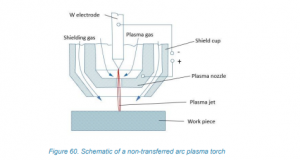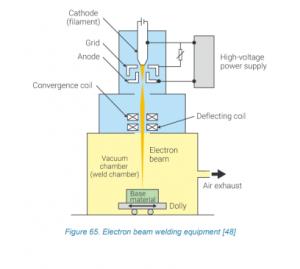Lesson 3: WELDING III – welding processes, fusion welding processes
In this lesson, we will delve into fusion welding processes, which employ various heat sources to create strong bonds between materials.
- GAS WELDING
- Gas welding utilizes burning as a heat source.
- Acetylene burned in oxygen produces a high flame temperature of 3160°C.
- Caution is essential due to acetylene’s explosive nature.
- Proper ventilation is crucial to prevent carbon monoxide formation.
- Although less commonly used now, it was valued for its independence from electricity.

- THERMITE WELDING
- This process relies on chemical energy as well.
- It begins with a reaction initiated by a thermite igniter or an acetylene-oxygen flame.
- Temperatures exceeding 2000°C are required.
- The reaction produces thermite iron and significant heat.
- Cooling is necessary, and steel pieces are added for this purpose.
- Alloy quality is achieved through additives like coke, manganese, silicon, titanium, and vanadium.
- ELECTROSLAG WELDING
- Electroslag welding is a mechanized process using Joule heat.
- Initially, it starts as an arc welding on a cutoff plate.
- The heat of the arc melts the welding flux to form slag.
- Slag takes over current conduction, extinguishing the arc.
- SUBMERGED ARC WELDING
- A high-power, automated process suitable for long seams on thick plates.
- An electrical arc burns between the consumable wire electrode and the workpiece.
- Welding flux is fed onto the workpiece, and a vacuum cleaner collects unused flux.
- MANUAL METAL ARC (MMA) WELDING WITH COATED ELECTRODE
- An early arc welding process.
- Arc forms under the protection of the electrode coating.
- Versatile and cost-effective, used for various metals.
- Limited deposition rate and quality affected by human factors.

- GAS METAL ARC WELDING
- Gas Metal Arc Welding (GMAW) processes are highly productive and easily automated.
- It utilizes a burning arc between a mechanically fed consumable wire electrode and the workpiece.
- Protective gas flows through a nozzle to shield the weld and stabilize the arc.
- Inadequate gas protection can lead to issues such as gas porosity and alloying element loss.
- Shielding gas can be inert or active, e.g., Argon and Helium.
- TUNGSTEN INERT GAS (TIG) WELDING
- TIG welding employs a non-fusing tungsten electrode and a shielding gas.
- It is manually guided, similar to gas welding.
- Arc can be ignited by lifting the electrode or using a high-frequency igniter.
- Various electrode materials and diameters are available.
- PLASMA WELDING
- Plasma is a medium with high temperatures and ionization.
- Plasma welding uses an electric arc to create plasma.
- Temperature can reach 5000-50000°C.
- Various gases are used for plasma formation.
- Plasma arc characteristics differ from regular arcs.

- LASER WELDING
- Laser stands for Light Amplification by Stimulated Emission of Radiation.
- Laser-active material is brought into a state of population inversion, resulting in amplified emission.
- Laser welding involves an intense, focused laser beam.
- Precise and efficient, it’s used for various applications.
- ELECTRON BEAM WELDING
- High-speed electrons in an electron beam are converted into thermal energy on impact with the workpiece.
- Welding is conducted in a vacuum chamber to avoid rapid electron deceleration due to air particles.
- Precautions include demagnetization, radiation protection, and cleanliness.

Conclusion:
- Fusion welding processes utilize diverse heat sources, from burning gases to laser beams, to create strong material bonds.
- Each welding method has distinct advantages and is chosen based on factors like material type, thickness, and application.
- Safety and precision are paramount in welding, as processes may involve high temperatures, potential hazards, and specific techniques.
- Understanding these fusion welding processes equips professionals with the knowledge to select the right method for various welding applications.
- Welding continues to play a critical role in industries ranging from construction to aerospace, underlining its importance in modern manufacturing.
In this lesson, you’ve explored a variety of fusion welding processes that use different heat sources to create strong bonds between materials. Each process has its advantages and applications, making them valuable tools in various industries.